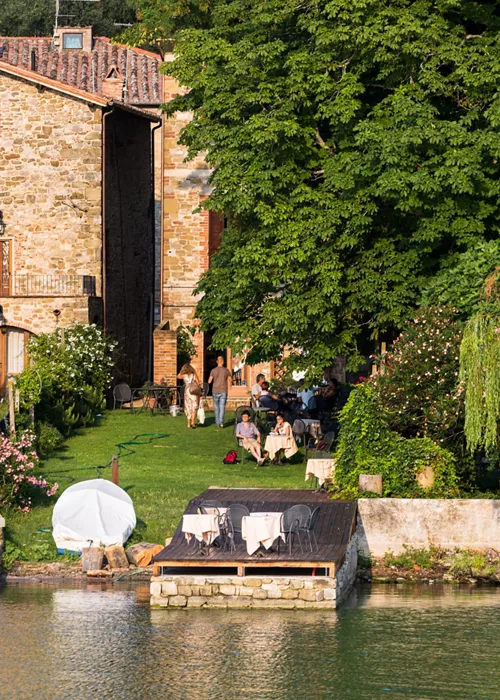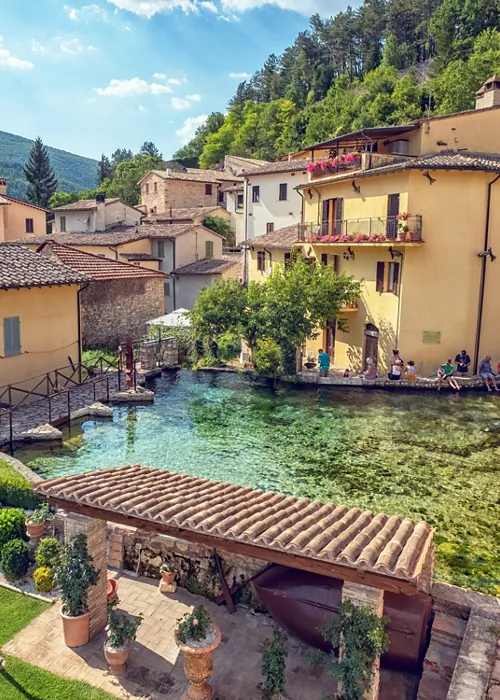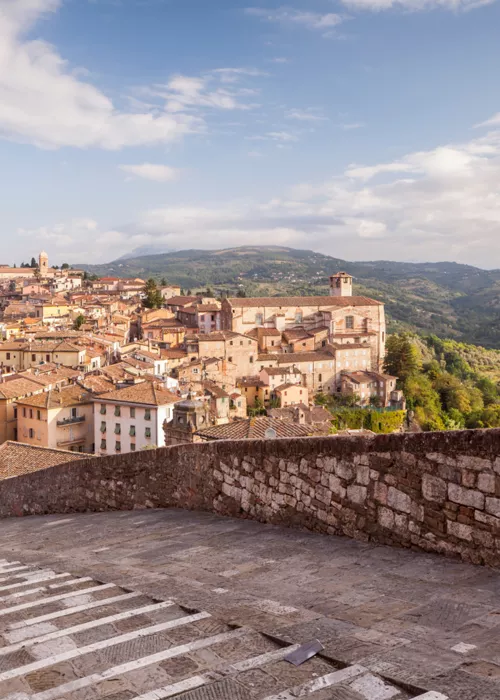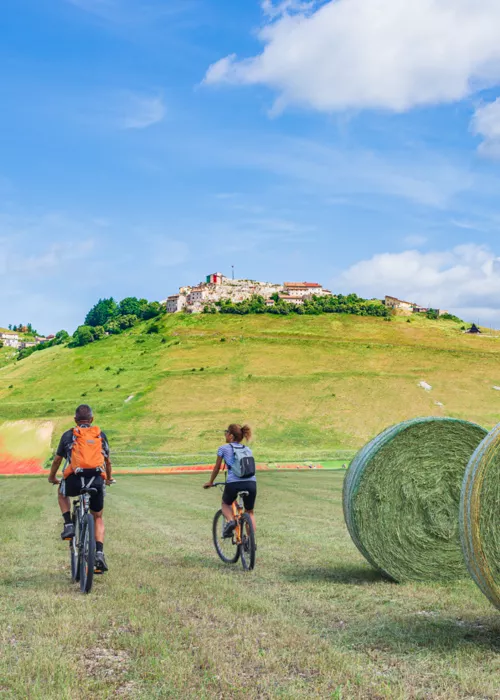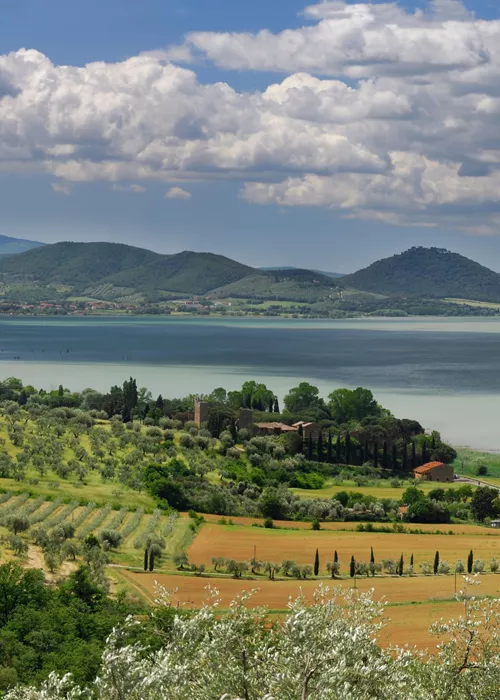Marmore Falls

In a land as silent and quiet as the Ternano area, finding oneself in front of the deafening and mighty jet of the Marmore Falls is a striking experience. This naturalistic wonder, seemingly untouched but actually the work of man, is kept within the boundaries of the protected area of the Nera River Park.
It was 271 BC and, in the middle of the Roman republican era, that the consul Manio Curio Dentato decided to build a canal capable of draining the waters of the Lacus Velinus towards the course of the Nera river. The Velinus was, at the time a particularly extensive and unhealthy marshland whose waters had to be drained and diverted away from the nearby important city of Rieti.
Already at the time of the eighteenth-century Grand Tour, painters, poets and other protagonists of the European art scene were impressed by the dizzying height of this artificial waterfall. Three very steep drops now total 165 metres of altitude difference, putting the Marmore Falls in first place for height in Europe.
Several trails of various difficulties allow travellers with children to easily approach the jets of water, which on sunny days create playful colourful reflections.
The park includes a bar, cafeteria and picnic area; information on environmental education activities for children can be obtained at the ticket office.
Lake Piediluco

Just a few kilometres east of the warerfalls of Marmore Falls you will find yourself immersed in the tranquility of Lake Piediluco: the second-largest natural body of water in Umbria, after Lake Trasimeno, is famous for the immobile calm of its waters, which make it a particularly popular destination for various water sports, such as boating, kayaking and stand-up paddleboarding, a variant of surfing.
The village of Piediluco also offers art and culture enthusiasts a number of significant points of interest, such as those offered by the Gothic church of San Francesco or the fourteenth-century ruins of the city fortress, which watches over the town from above. On the other side of Lake Piediluco, Mount Caperno offers a network of hiking trails of various difficulties that culminate in front of the white sculpture of the Madonna dell'Eco.
The waters of Lake Piediluco, between the end of June and the beginning of July, finally host the Water Festival. It is an ancient celebration of the summer solstice that, between pyrotechnic shows and crowded medieval historical re-enactments, ends with an evocative nocturnal parade of boats, particularly loved by children.
Ferentillo

Before visiting Ferentillo, going up the course of the Nera river from the Marmore Falls, to the north, you meet some ancient and fascinating villages of medieval origin. Among these, the town of Arrone, chosen by the director Mario Monicelli to shoot part of his work "L'Armata Brancaleone", certainly deserves a detour. Children can recreate the scenes of this historic film by running through the alleys of the village.
A little further on, the bucolic landscape of Ferentillo opens up. The passage of the Nera river divides the town into two districts: that of Matterella, on the right bank, dominated by a harsh cliff, and that of Precetto, on the opposite side of the Nera river. It is precisely in Precetto that you have to go to discover one of the best-known attractions of Ternano: the Museum of the Mummies of Ferentillo.
In Precetto, from the 16th century until the beginning of the 19th century, it was customary to bury the dead in the underground crypt of the church dedicated to San Stefano. When this custom was interrupted in Napoleonic times, the inhabitants of Precetto discovered that as many as twenty-four of the corpses buried during some three centuries had been kept in an exceptional state of preservation. The mummies of Ferentillo attract the curiosity of young and old, along an unusual visit route.
The harmonious geometries of the Abbey of San Pietro in Valle, just outside the main town of Ferentillo, deserve a final detour. The central body of the church,beautifully frescoed, can be visited by reservation: what were once the monks' rooms, refectories, and common rooms have instead been transformed into a period residence, for an incredibly charming stay.
Carsulae archaeological area

Travelling towards the outskirts of Terni, while remaining outside the city centre, it only takes a few minutes' drive north-west to reach a pearl of Umbrian history and culture: the archaeological area of Carsulae.
An important city of Roman foundation, Carsulae was strategically positioned on the historic Via Flaminia which, in the direction of Rimini, crossed and still crosses the archaeological area today.
The well-preserved finds of Carsulae today take visitors, young and old, on a journey through time. Between imposing columns, mighty walls and cobbled streets, the tour stimulates the imagination and helps us understand what daily life might have been like in antiquity.
In Carsulae, the remains of a theatre , an amphitheatre and the city forum stand out for their importance. The arch of S. Damiano, a majestic structure that served as the northern access to the city, is finally among the most recognisable symbols of the archaeological area.
The fossil forest of Dunarobba

Extending the route from the archaeological area of Carsulae, still further west, you arrive after about fifteen kilometres in the locality of Dunarobba. After exploring the history, nature and archaeology of Ternano, this last stage offers the traveller the opportunity to visit a truly unique geological site.
About fifty trunks, which belonged millions of years ago to very large trees, form the fossil forest of Dunarobba. The site was discovered in the 1970s by some workers who were recovering brick-making material in this locality.
Since then, Dunarobba has attracted geology experts along with curious individuals and travellers of all kinds, including the smallest ones who are fascinated by these "mummified trees".
A guided tour by reservation will certainly be able to better explain, to adults and children, how these gigantic plants (which exceed one and a half metres in diameter) have been preserved for about 2–3 million years, buried under metres of sand and clay.



